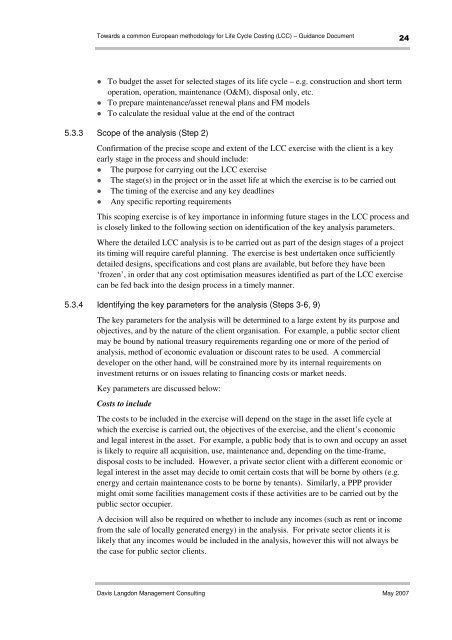Life cycle costing (LCC) as a contribution to sustainable construction ...
Life cycle costing (LCC) as a contribution to sustainable construction ...
Life cycle costing (LCC) as a contribution to sustainable construction ...
Create successful ePaper yourself
Turn your PDF publications into a flip-book with our unique Google optimized e-Paper software.
Towards a common European methodology for <strong>Life</strong> Cycle Costing (<strong>LCC</strong>) – Guidance Document<br />
24<br />
To budget the <strong>as</strong>set for selected stages of its life <strong>cycle</strong> – e.g. <strong>construction</strong> and short term<br />
operation, operation, maintenance (O&M), disposal only, etc.<br />
To prepare maintenance/<strong>as</strong>set renewal plans and FM models<br />
To calculate the residual value at the end of the contract<br />
5.3.3 Scope of the analysis (Step 2)<br />
Confirmation of the precise scope and extent of the <strong>LCC</strong> exercise with the client is a key<br />
early stage in the process and should include:<br />
The purpose for carrying out the <strong>LCC</strong> exercise<br />
The stage(s) in the project or in the <strong>as</strong>set life at which the exercise is <strong>to</strong> be carried out<br />
The timing of the exercise and any key deadlines<br />
Any specific reporting requirements<br />
This scoping exercise is of key importance in informing future stages in the <strong>LCC</strong> process and<br />
is closely linked <strong>to</strong> the following section on identification of the key analysis parameters.<br />
Where the detailed <strong>LCC</strong> analysis is <strong>to</strong> be carried out <strong>as</strong> part of the design stages of a project<br />
its timing will require careful planning. The exercise is best undertaken once sufficiently<br />
detailed designs, specifications and cost plans are available, but before they have been<br />
‘frozen’, in order that any cost optimisation me<strong>as</strong>ures identified <strong>as</strong> part of the <strong>LCC</strong> exercise<br />
can be fed back in<strong>to</strong> the design process in a timely manner.<br />
5.3.4 Identifying the key parameters for the analysis (Steps 3-6, 9)<br />
The key parameters for the analysis will be determined <strong>to</strong> a large extent by its purpose and<br />
objectives, and by the nature of the client organisation. For example, a public sec<strong>to</strong>r client<br />
may be bound by national tre<strong>as</strong>ury requirements regarding one or more of the period of<br />
analysis, method of economic evaluation or discount rates <strong>to</strong> be used. A commercial<br />
developer on the other hand, will be constrained more by its internal requirements on<br />
investment returns or on issues relating <strong>to</strong> financing costs or market needs.<br />
Key parameters are discussed below:<br />
Costs <strong>to</strong> include<br />
The costs <strong>to</strong> be included in the exercise will depend on the stage in the <strong>as</strong>set life <strong>cycle</strong> at<br />
which the exercise is carried out, the objectives of the exercise, and the client’s economic<br />
and legal interest in the <strong>as</strong>set. For example, a public body that is <strong>to</strong> own and occupy an <strong>as</strong>set<br />
is likely <strong>to</strong> require all acquisition, use, maintenance and, depending on the time-frame,<br />
disposal costs <strong>to</strong> be included. However, a private sec<strong>to</strong>r client with a different economic or<br />
legal interest in the <strong>as</strong>set may decide <strong>to</strong> omit certain costs that will be borne by others (e.g.<br />
energy and certain maintenance costs <strong>to</strong> be borne by tenants). Similarly, a PPP provider<br />
might omit some facilities management costs if these activities are <strong>to</strong> be carried out by the<br />
public sec<strong>to</strong>r occupier.<br />
A decision will also be required on whether <strong>to</strong> include any incomes (such <strong>as</strong> rent or income<br />
from the sale of locally generated energy) in the analysis. For private sec<strong>to</strong>r clients it is<br />
likely that any incomes would be included in the analysis, however this will not always be<br />
the c<strong>as</strong>e for public sec<strong>to</strong>r clients.<br />
Davis Langdon Management Consulting May 2007







